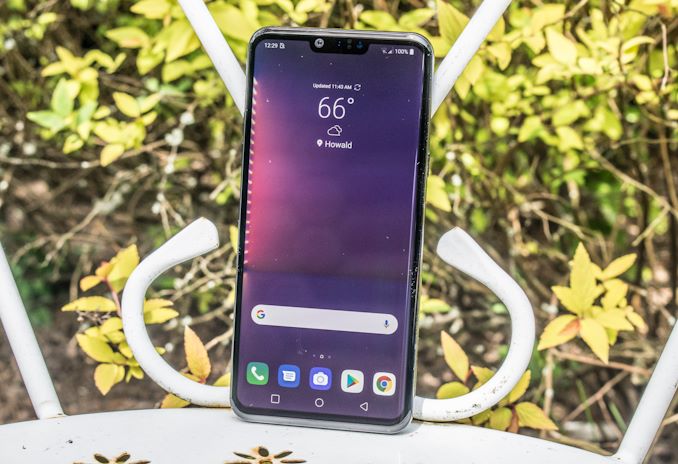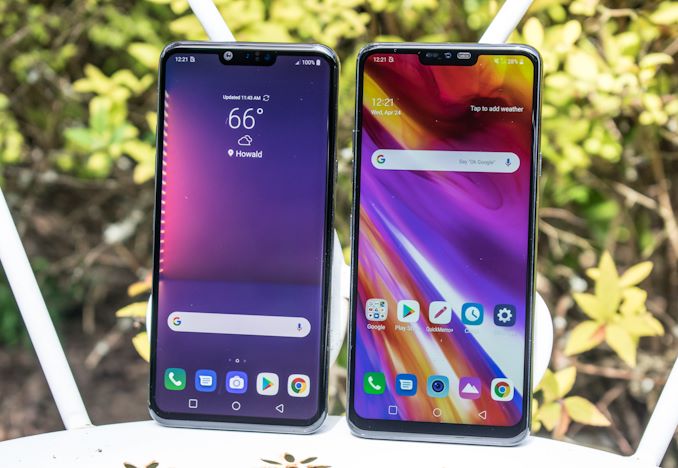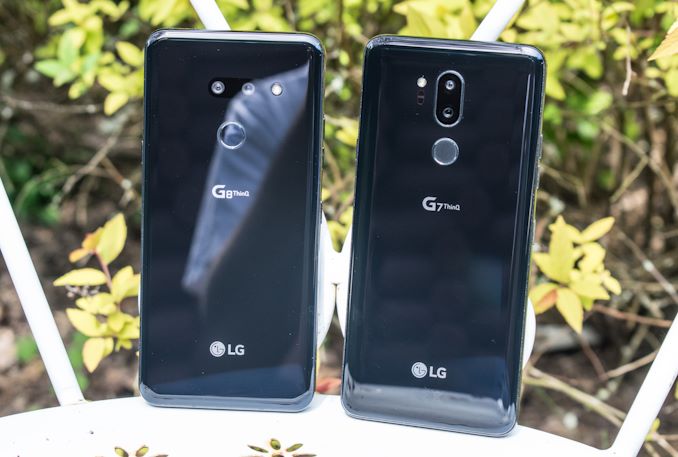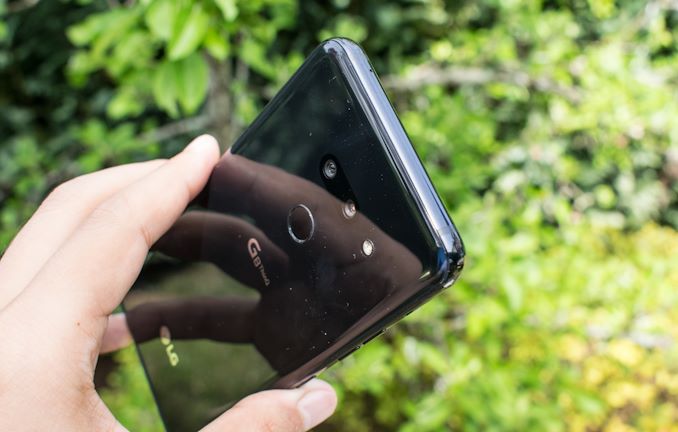The LG G8 Review: Solid, But Not Great
by Andrei Frumusanu on April 30, 2019 1:00 PM EST- Posted in
- Mobile
- LG
- Smartphones
- LG G8
- LG G8 ThinQ

Only a few years ago LG was largely considered one of the top smartphone brands, competing alongside Samsung and the likes of HTC for marketshare. In the last few years however, LG has had quite a bit of a rough time, unable to deliver differentiating products and sometimes failing to deliver on some important basics in a smartphone. The result is dwindling marketshare numbers and less than stellar financial reports.
Today, the new LG G8 ThinQ is the newest iteration in LG’s line-up, bringing the newest technologies to the table and improving on last year’s model. One important thing to note about the G8 is that LG is no longer positioning the phone as the company’s flagship product, a position which now officially belongs to the V-series such as the upcoming V50.
The G8 thus doesn’t try to be revolutionary, and instead focuses on improving on some of the core aspects of what makes it a smartphone, with some gimmicks thrown in in an attempt to differentiate itself. Arguably, the most important distinction for the G8 is that this is the first phone in the series that comes with an OLED screen which represents a major shift in terms of LG’s past product segmentation between the G and V series.
| LG G8 ThinkQ | |||
| LG G8 | |||
| SoC | Qualcomm Snapdragon 855 1x Kryo 485 (Cortex-A76) @ 2.84GHz 3x Kryo 485 (Cortex-A76) @ 2.42GHz 4x Kryo 485 (Cortex-A55) @ 1.80GHz Adreno 640 @ 585MHz |
||
| Display | 6.1" OLED 3120 x 1440 (19.5:9) |
||
| DRAM | 6GB LPDDR4X | ||
| Storage | 128 GB | ||
| Dimensions | 151.9 x 71.8 x 8.4mm | ||
| Weight | 167g | ||
| Battery Capacity | 3500mAh | ||
| Wireless Charging | Qi | ||
| Rear Cameras | |||
| Main | 12MP 1.4µm Dual Pixel PDAF f/1.5 OIS 27mm eq. (78°) angle |
||
| Wide | 16MP 1.0µm f/1.9 Fixed Focus 16mm eq. (107°) angle |
||
| Front Camera | 8MP 1.22µm | ||
| I/O | USB-C 3.5mm headphone jack |
||
| Wireless (local) | 802.11ac Wave 2 Wi-Fi 2x2 MIMO Bluetooth 5.0 LE |
||
|
|
|||
| Dual-SIM | Single-SIM / Dual-Hybrid depending on market | ||
| Launch Price | $619 - $849 depending on carrier & variant | ||
In terms of hardware, the new LG G8 ThinQ ticks the marks in terms of offering the newest 2019 components, including the new Qualcomm Snapdragon 855 SoC. As seen in our Galaxy S10 review, the new SoC offers excellent performance and power efficiency and we’re expecting no less of the new G8.
LG makes the memory and storage options choice simple: The G8 only comes with a 6GB RAM and 128GB NAND (UFS 2.1) storage variant and avoids any up-sell models, instead relying on the microSD capability for more storage. Last year’s G7 also came with a 64GB storage option, which I would have argued might not have been sufficient for everybody, but the new 128GB base option should satisfy the vast majority of users, bar video-recording power users.
Pitting the new LG G8 against last year’s G7, we see very similar designs, yet the new model’s design is more refined:
LG has opted to continue to use a display notch for the G8, however this year the company has replaced the earpiece with a new time-of-flight (ToF) sensor. LG uses the ToF sensor in a unique way, enabling Minority Report-like navigatiion and controlgestures when hovering your hand in front of the screen, including an option to unlock your phone via hand vein recognition.
The biggest change between the G7 and G8 is something that from a distance isn’t immediately visible: the display panel technology. The display shares the same 6.1” 3120 x 1440 resolution and 19.5:9 characteristics of its predecessor, however this is now an OLED panel instead of last year’s RGBW LCD screen.
As mentioned, this is the very first OLED phone in LG’s G-series, a feature that in the past was dedicated to distinct series (Flex lineup) or the newer V-series models. This had me worried for the G8 as LG’s history with mobile OLED screens has been quite tainted: The Flex series’ screens were grainy disasters, while subsequent devices such as the V30 had large manufacturing variations which resulted in visible unevenness in the screen. Last year’s V40 had good display characteristics, however the phone was tainted by abysmal power consumption which I ended up attributing to the display panel, as we saw similar degradation in other manufacturers’ phones who opted to use LG displays. This latter issue however was found on the LCD G7 – largely eliminating the RGBW display's power efficiency benefits at lower brightness levels.
Given the company's history with mobile OLED screen, it’ll be incredibly important for LG to get the G8 display right, as it will be a determining factor as the centre-piece of the phone, as well as a major factor for the phone’s battery life.
The G8 shares the same form-factor as its predecessor, and the back of the phones are similar glass slabs. LG has opted to continue to use a rear capacitive fingerprint sensor which still works excellently. While LG could have opted to use an optical front under-screen sensor, it’s not a major negative for the phone in my opinion.
What isn’t directly visible in the comparison shots is another internal design change: The new G8 increases the battery capacity from 3000mAh on the G7 to a new 3500mAh capacity module, representing a 16% increase. This was a major concern for the G7 which had reduced its capacity from the 3300mAh of the G6, so it’s good to see LG recoup that difference and add on to it.
The battery increase however didn’t come without compromises as the new phone is now slightly thicker at 8.4 versus last year’s 7.9mm. It’s not an issue for the ergonomics, as the phone remains of a smaller form-factor at 71.8mm width. The increase however is immediately noticeable, especially because LG has opted to reduce the curvature of the back glass, more noticeably thickening the edges of the new phone, even when accounting for the new curvature of the front display glass. Again, it’s not an issue for me, but it does feel less premium as other new more streamlined designs by the competition.
The biggest design change of the G8 is in the camera orientation and housing. It seems that the increased thickness of the new phone has allowed LG to make the cameras flush with the back glass. In fact, the back glass serves as the glass protection for the cameras. In terms of design, this does look great and represents a unique feature that we haven’t seen in smartphones in several years now (Pixel 1 if I'm not mistaken). It’s to be noted that this flush design is interrupted by the LED flash which does have a cut-out in the glass, and naturally also the fingerprint sensor.
While the new design looks great, I have concerns about reliability: Because the back glass serves as the protection for the camera, it means that the cameras will be just as prone to scratches as the rest of the phone as it doesn’t have a protective raised physical barrier (metal rim) or recessed harder dedicated glass from the rest of the phone. Minor scratches might not appear in camera shots other than light artefacts in low-light, however let’s hope users don’t get any major scratches directly in front of the camera modules.
In terms of the cameras themselves, LG is doing some odd regional model segmentations. The G8 at MWC was presented as a triple-camera phone with dual-camera models for specific regions. In the end, the triple-camera variant seems to have ended up only in Korea as the US and Europe are seemingly getting the dual-camera variants, such as our review model. This is actually quite the competitive disadvantage for the G8, especially in the face of Samsung and Huawei’s newest triple-camera flagships. What’s more odd is that the Korean G8 with the triple camera setup doesn’t look to compromise anywhere else in terms of its specifications, and still comes in with similar full MSRPs. I just wish LG had gone with the full camera setup globally.
The wide angle sensor seems to remain the same as on the G7, a 16MP 1µm sensor with an f/1.9 107° wide-angle lens. The main sensor is where we see LG make big changes compared to the G7, as the new phone comes with the same 12MP 1.4µm sensor and f/1.5 78° main camera lens with OIS first introduced in the V40.
On the left side of the phone we find the two volume buttons as well as a dedicated button for Google Assistant. On the right side we find the power button as well as a wide SIM/microSD tray. It’s to be noted that in some markets the phone comes in a dual-SIM variant with a hybrid SIM/µSD slot as the second slot.
In regards to the speaker, we mentioned that LG had opted to remove the earpiece, but this doesn’t mean that the phone is limited to the bottom speaker. Under the display at about the level underneath the rear cameras we find a new piezoelectric exciter which vibrates the screen assembly, which in turn serves as a speaker. LG’s implementation surprisingly enough is quite good, although not as great as a dedicated powerful earpiece speaker. More importantly, the new under-screen speaker also now serves as a second speaker for stereo playback, which is a massive improvement over last year’s mono G7.
Overall, the G8’s new design isn’t anything ground-breaking. LG has made good functional improvements to the G7’s design while remaining true to it. It’s actually weird that I don’t have too much to say about the phone’s design, and if I had to critique anything about is that it does seem very conservative than some of the newer, more exciting competition.
















70 Comments
View All Comments
PeachNCream - Thursday, May 2, 2019 - link
You audio people are oddities to say the least. Most of us don't really care about what umoos and ah-ahs are driving our transmorgofiers in high-low-moosepedience headphones and we don't think that one thing "destroys" another thing in terms of sound quality in our car (which is filled with road noise) because we don't live in our vehicles. While it's perfectly fine that you care and you hear things that the rest of us just shrug about, most of us use a cheap pair of earbuds or headphones we spent less than $20 on, never do anything to our car's sound besides turning the radio on or off, and sometimes spend hours playing 128kbps mp3s on a phone's integrated speaker because who cares anyway. I suggest not worrying about it. Do your research, live deep in that fidelity world, and don't hassle the reviewers for skimming over stuff that is entirely unimportant for the vast majority of us that only care to the extent that we can hear the phone ring when we get a call.ZolaIII - Sunday, May 5, 2019 - link
Don't, I mean even assume you are speaking for majority of people. There is a gear that is both affordable and sounds rather good. From product that are in music lovers category to entry level audiophile one's. So you can buy a more than decent can's for 25~30$ (for example Superlux HD-668B over the ear or MEE M6 Pro first gen EMI's), hopefully the good DAC for 25~30$ soon or a DAP (DAC, BT) for 100$ right now, while pair of good car speakers (main bass/mids unit's + twitters) is around 140$. Problem with LG is that their implementation simply isn't really good to shine with budget lo impedance headphones.joser0913 - Thursday, October 10, 2019 - link
Andrei, you might want to read this article (http://somegadgetguy.com/2017/11/30/how-android-po...I think Juan Bagnell, as well as many other reviewers are right, LG delivers the best wired headphone experience and that should be highlighted
ZolaIII - Wednesday, May 1, 2019 - link
You don't use headphones for the measurement that's actually very wrong approach. I assume nothing changed much nor did LG make it right as usual so it probably stayed the same.https://www.audiosciencereview.com/forum/index.php...
While DAC is very capable for actually enjoying it with low impedance headphones as most people use it anyhow you need to look elsewhere, recommended goes for times being to Shanling M0 DAP for some 100$. We will see how things go with Meizu's new USB DAC dingle...
dxcanas - Tuesday, April 30, 2019 - link
The G8's site describes a "night shot mode" at the bottom of the page, and I've read of it in other reviews. I couldn't find any mention of this mode in the llow light evaluation - was it not helpful?https://www.lg.com/us/mobile-phones/g8-thinq/camer...
Andrei Frumusanu - Tuesday, April 30, 2019 - link
There's no dedicated mode, it just automatically goes into a lower light mode. It's active in the sample shots.Andrei Frumusanu - Wednesday, May 1, 2019 - link
As a correction, the mode is actually there as a dedicated mode buried in the "More" mode settings. It gives the same results as auto in low-light.dxcanas - Wednesday, May 1, 2019 - link
Cool, thanks for the update and correction!Peddy2299 - Wednesday, May 1, 2019 - link
LG makes some if the best phones on the market. The best phones for me on the market arr LGs. They meet my daily phone needs on the high-end basis. No other phone does that for me. All the comparing on stuff those other brands just don't work out for me.sonny73n - Wednesday, May 1, 2019 - link
Sure. Because you don’t have much to choose from at local stores if you live in the US. It’s hard to buy something when you can’t physically feel it. But if you dare to take a risk with one of those Chinese phones like Huawei, Meizu, Oppo or ZTE, I’m sure you won’t be disappointed because they’re much better in terms of performance and quality per dollar. They won’t rob you like LG, Samsung, Sony or Apple do.I used to buy at least 2 “high end” phones per years just for myself. Glad I woke up. Now a $300 Chinese phone is just as good.